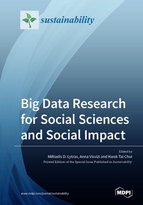Big Data Research for Social Sciences and Social Impact
A special issue of Sustainability (ISSN 2071-1050).
Deadline for manuscript submissions: closed (10 April 2019) | Viewed by 122811
Special Issue Editors
2. Effat College of Business, Effat University, Jeddah 21551, Saudi Arabia
Interests: smart cities; smart villages; international political economy (IPE); information and communication technology (ICT)
Special Issues, Collections and Topics in MDPI journals
Interests: cognitive computing; artificial intelligence; data science; bioinformatics; innovation; big data research; data mining; emerging technologies; information systems; technology driven innovation; knowledge management; semantic web
Special Issues, Collections and Topics in MDPI journals
Interests: big data; bioinformatics; computational intelligence; data science; energy monitoring and management; intelligent transportation; optimization; semantic web
Special Issues, Collections and Topics in MDPI journals
Special Issue Information
Dear Colleagues,
Social good is generally an action or application that benefits society. In the past, it was usually driven by governments and non-profit organizations. With the advancement of social media via computer-mediated technologies like WeChat, WhatsApp, Weibo, Twitter, Instagram, Facebook, and YouTube, billions of registered users utilize social interactions through social media. As a result, everyone can contribute to society easily and achieve social good.
Tremendous growth of digital information (from granular data to aggregated data) is available for numerous social sciences and social impact applications, for instance, environmental protection, healthcare and education. Data analytics are ubiquitous and purpose-oriented in different forms: Descriptive analytics, diagnostic analytics, predictive analytics and prescriptive analytics. Typical challenges for adopting big data technologies for social sciences and social impact are data handling and storage, data quality, computational power of computer, algorithm customization for special application and security. More importantly, it seems that the humans have an infinite need of utilizing the value of big data for social impact and thus applications on social good. We have to prioritize the applications and more research efforts will be devoted to more important issues.
This Special Issue aims to consolidate recent advances in big data for social good. Pilot studies and projects are especially welcome.
Topics of interest for this Special Issue include (but are not limited to):
- Innovative applications of data analytics to social sciences and social impact problems like energy, healthcare, education, food, poverty, injustice, and inequalities in society
- Machine learning algorithms for big data applications for social sciences and social impact
- Advanced techniques for handling unstructured, unlabeled and/or missing data
- Data quality control of big data for social good
- Big data research driven policy making for social impact
- Standardization for big data infrastructure and framework
- Big data implications to society
- Big data driven KPIs research for International Benchmarking
- Social inclusive economic development and growth through big data applications
- Human centric big data research
- Ethical issues on social research of big data
- Sustainability for social impact research
- Sustainable data-driven ecosystems for international collaboration
- Multi-objective optimization
- Meta-analysis
- Security and privacy
- Co-simulation
Prof. Anna Visvizi
Prof. Miltiadis D. Lytras
Dr. Kwok Tai Chui
Guest Editors
Manuscript Submission Information
Manuscripts should be submitted online at www.mdpi.com by registering and logging in to this website. Once you are registered, click here to go to the submission form. Manuscripts can be submitted until the deadline. All submissions that pass pre-check are peer-reviewed. Accepted papers will be published continuously in the journal (as soon as accepted) and will be listed together on the special issue website. Research articles, review articles as well as short communications are invited. For planned papers, a title and short abstract (about 100 words) can be sent to the Editorial Office for announcement on this website.
Submitted manuscripts should not have been published previously, nor be under consideration for publication elsewhere (except conference proceedings papers). All manuscripts are thoroughly refereed through a single-blind peer-review process. A guide for authors and other relevant information for submission of manuscripts is available on the Instructions for Authors page. Sustainability is an international peer-reviewed open access semimonthly journal published by MDPI.
Please visit the Instructions for Authors page before submitting a manuscript. The Article Processing Charge (APC) for publication in this open access journal is 2400 CHF (Swiss Francs). Submitted papers should be well formatted and use good English. Authors may use MDPI's English editing service prior to publication or during author revisions.
Keywords
- Big data research
- Social and humanistic computing
- Social sciences
- Social good
- Social impact
- Machine learning
- Knowledge management
- Web science
- Data science
- Social inclusive economic growth
- Sustainability
- Innovation
- Innovation networks
- Semantics
- Cloud computing
- Silk road








